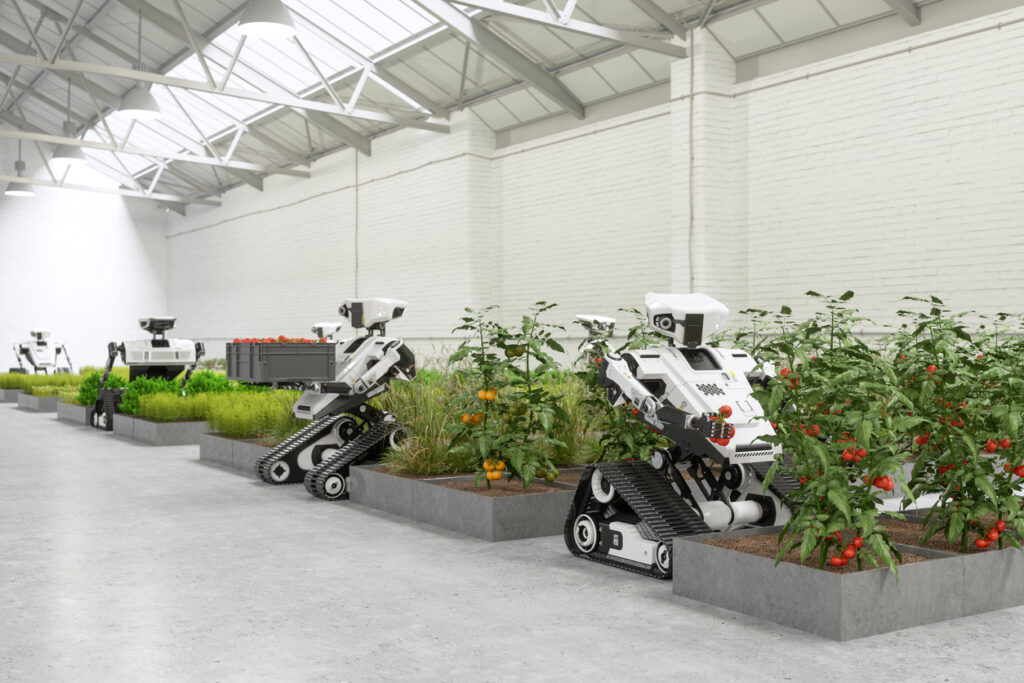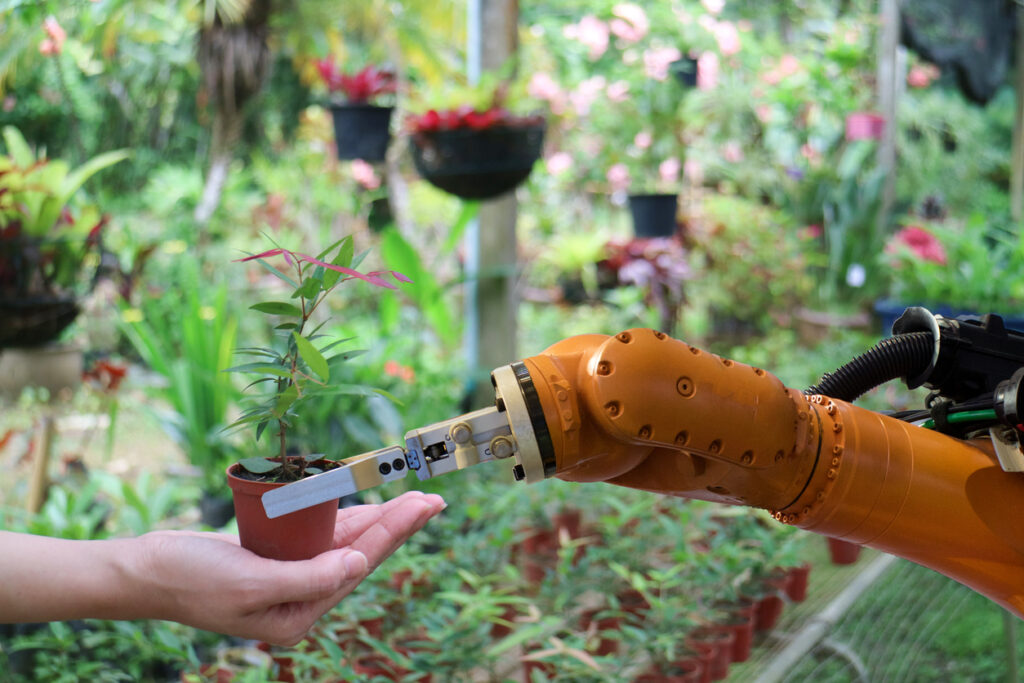While automated agricultural equipment technically dates back a hundred years, true agriculture-focused robots only became viable towards the end of the 20th century. It is the significant advancements in computing power and machine vision in particular that have now made robots practical within an agricultural context.
As the name suggests, agricultural robots are deployed for various farming-based jobs. They can be assigned to perform repetitive and physically grueling duties, instead of human workers. In addition, they can be used for carrying out more niche-specific agricultural tasks. According to BlueWeave Consulting, the global agricultural robotics market is set to see huge growth in the coming years. It is projected to reach annual revenues of $81 billion before the end of the decade.
Read more about the rising popularity of agricultural robots in our Robotics and Automation Guide. It looks at the applications they are being targeted at, as well as the challenges involved in their implementation.

Why Use Agricultural Robots?
Similar to any industrial machine, the robots employed in agriculture enable dramatic operational improvements to be realized. Consequently, farmers can increase overall efficiencies and augment the production yield of their land. Other advantages of putting robots to work on farms include:
- Farm deployed robots make fewer errors and operate at higher speeds than human workers can.
- Agricultural robots that feature weed and pest detection sensors allow farmers to lower pesticide usage, which thereby has ecological benefits. These intelligent machines ensure that spraying only needs to be done on affected areas, which can make farms relatively chemical-free.
- Much like other industrial robots, agricultural robots can operate right around the clock, with only minimal maintenance being needed. This reduces the dependence on human labor and curbs the overall cost of food production.
- Some agricultural robots can be equipped with various kinds of end effectors to make them more versatile and enable them to perform multiple tasks. This means that the investment needed can be spread more widely.
- Overall farm automation is making supply chains more efficient, ensuring minimal food wastage and greater profitability. This has the potential to lead to lower prices for consumers.
Despite all these plus points, there are still a few issues that must be addressed from a technological standpoint before agricultural robots will see widespread adoption. These will be outlined later.
Applications of Agricultural Robots & Components
So, what kind of agriculture-based tasks are robots able to perform? Here are a few key examples.
- Crop Seeding – The traditional method of planting seeds by scattering them can be less than optimal, with crop yields being detrimentally affected. Instead, autonomous seeding (helped by geo-mapping) ensures that the seeds are dropped at exactly the correct places and depths.
For measuring the level of liquids and solids in both huge seed silos and tiny storage containers, capacitive proximity sensors can be helpful. The CA30 sensors from Carlo Gavazzi are made to detect dry grain accurately. The sensor delivers a steady and accurate indication of the yield per unit area. Knowing these yields makes it simple to precisely alter the application of fertilisers and herbicides.
- Horticulture – Agricultural robots are of value in horticultural work, for the cultivation and delivery of potted plants. Among the numerous solutions for this is the one from Dutch firm, WPS. It offers smart picking and placing capabilities through its intelligent robotic arm, which is equipped with multiple sensors.
- Irrigation and Fertilizing – Precise irrigation systems aided by automation can significantly reduce water wastage. Though still in the research phase, agricultural robots have shown promise in traversing rows of crops and accurately sprinkling fertilizer or water on them.
- Harvesting – Picking crops is a repetitive process that is well suited to robots. It means that agricultural operations do not have to deal with the difficulties of recruiting seasonal workers (which in many countries are proving increasingly hard to find). It must be noted, however, that picked produce will need to be handled carefully, so as to prevent damage (otherwise there will be increased wastage levels to factor in). One company that specializes in harvesting strawberries is Harvest CROO. Their robots are designed to scan and determine the ripeness of berries and then pluck them without causing them any harm. To make harvesting even easier, Carlo Gavazzi provides a full variety of parts, ranging from inductive proximity sensors to passive magnetic pick-up sensors (PA2PK).

- Weeding – Weed control is always a challenge, with plants developing pesticide resistance and heightened consumer demand for organic food where only minimal chemicals have been used. Fortunately, certain agricultural robots are resolving this problem. The Ted robot platform specifically caters to vineyards, and works by distinguishing between crops and weeds, before mechanically removing the latter. It is easy to operate and highly accurate. Most importantly, with help from this technology, farms can avoid any use of herbicides.
- Crop Health Monitoring – Sophisticated drones set up with camera sensors and featuring AI can identify diseases in crops. Through this, farmers are able to conduct early interventions. Equinox Drones represent an example of this. These offer access to real-time imagery for early disease assessment in crops. In case of crop damage, they also provide valuable information to help farmers take remedial measures in the future.
- Phenotyping – Phenotyping in agriculture is the process of measuring and understanding the characteristics of crops (such as resistance, growth, yield and adaptation). This procedure helps in improving their traits with respect to future plant breeding. Robotics in phenotyping is a relatively new field, but several robotics systems are showing their effectiveness in measuring chemical and physiological characteristics of various plants over time. A Belgian company WIWAM has a series of phenotyping robots that allow for non-invasive imaging of plants.
Challenges for Agriculture Robots
Though this all looks encouraging, there are still some obstacles that need to be overcome. Researchers from Monash University have been among those who have questioned ‘smart farming’ methods, and the use of robotics in agricultural work. They have expressed concerns over damage to soil from heavy robots, as this may cause soil compaction to occur. They also fear that the standardization of the produce could lead to an increasing reliance on genetically modified crops more suited to automated farming.
A lot of electronic components in robotic automation also need to be ruggedized, as they are exposed to varying ambient conditions, with extremes of temperature and moisture experienced. This adds to the overall bill of materials costs. Also, the automation infrastructure required to operate agricultural robots (such as wireless connectivity) may be prohibitively expensive for smaller farms. With time, the cost aspect is likely to be less problematic – as the unit volumes increase, the pricing will become more attractive.
The application of robotics technology in relation to agriculture is advancing at a rapid pace in terms of the technology involved, and this is resulting in ever greater uptake. Via this, there is the prospect of a positive impact being witnessed – not just by farmers and the consumers they serve, but also on the environment, health and society at large.










